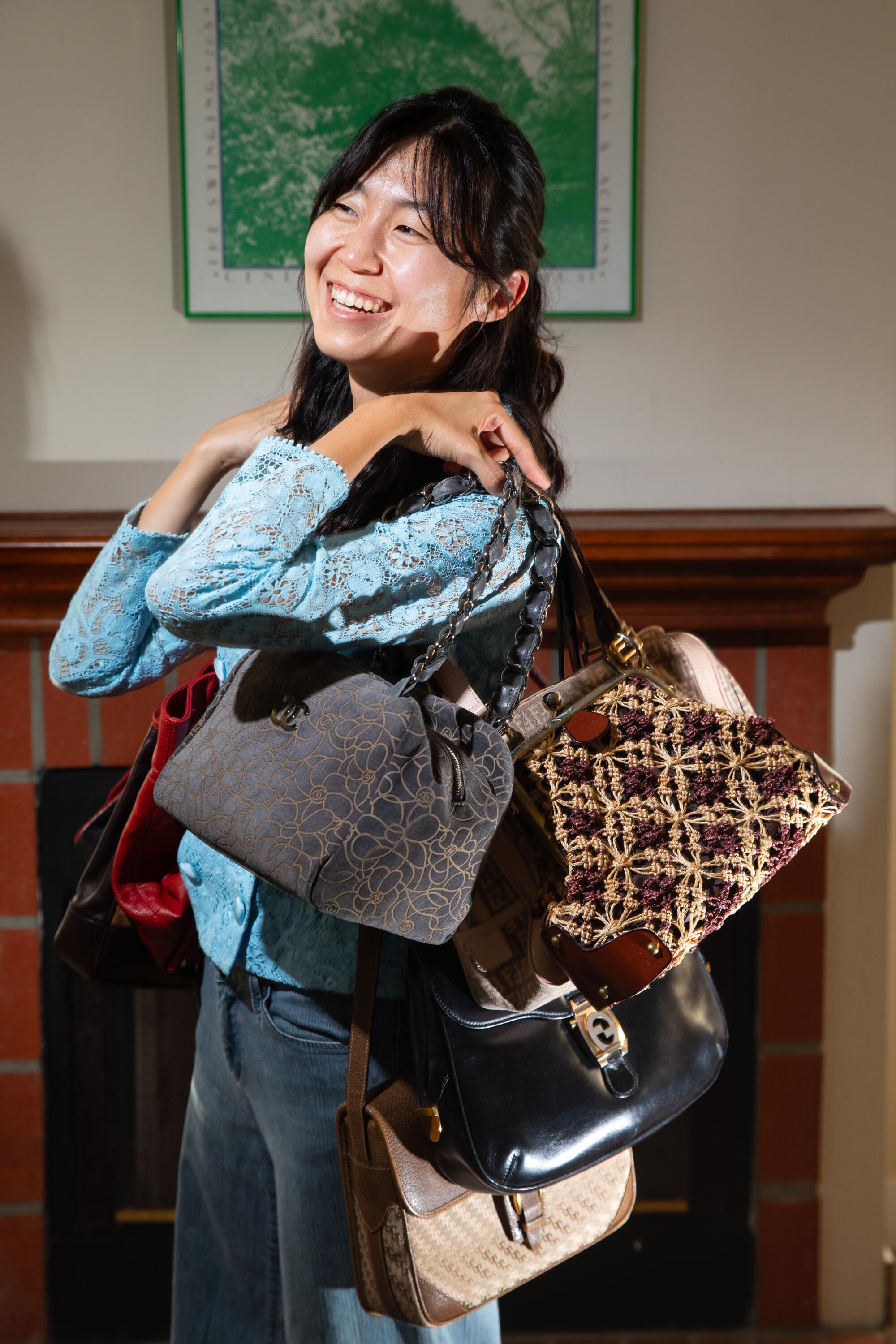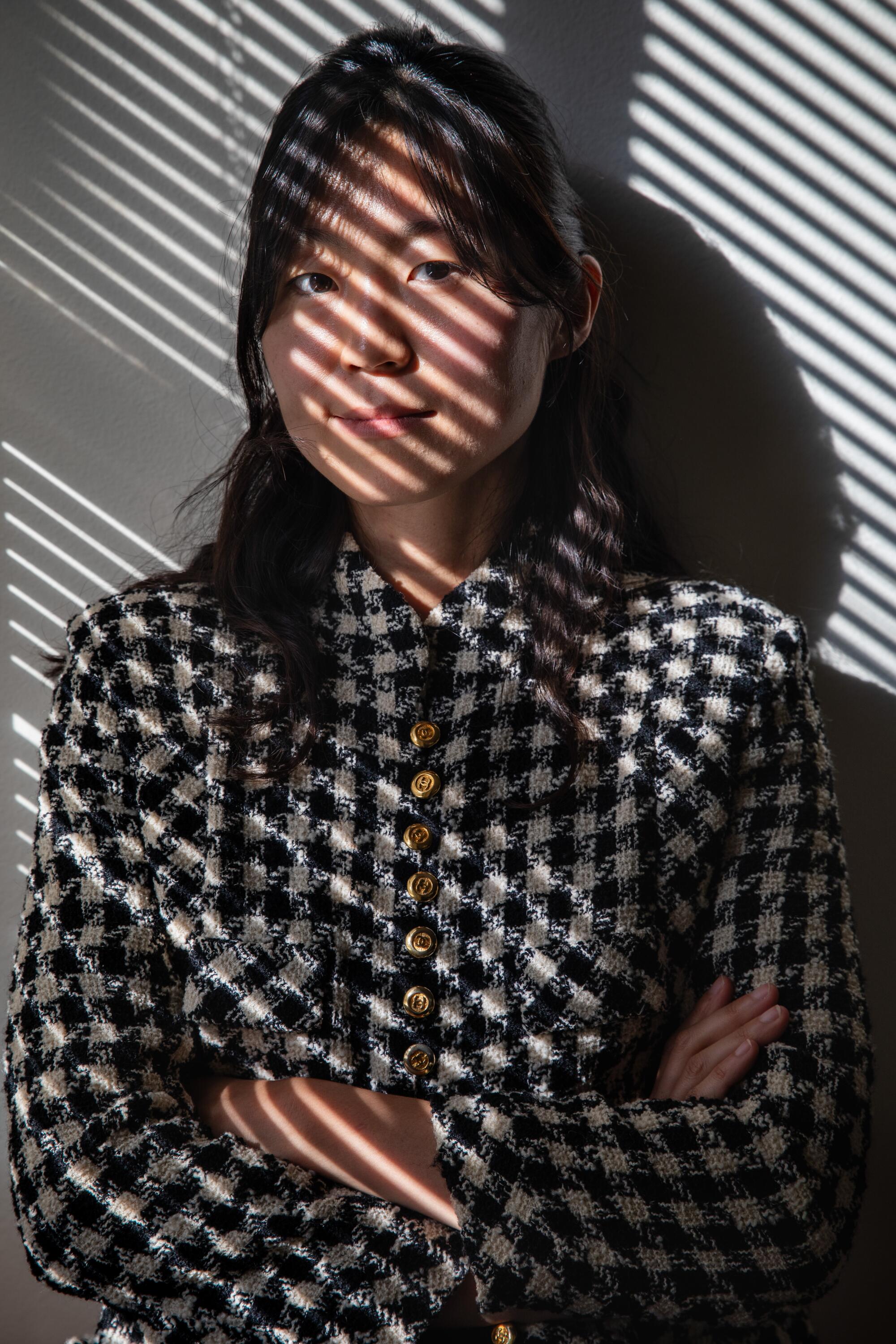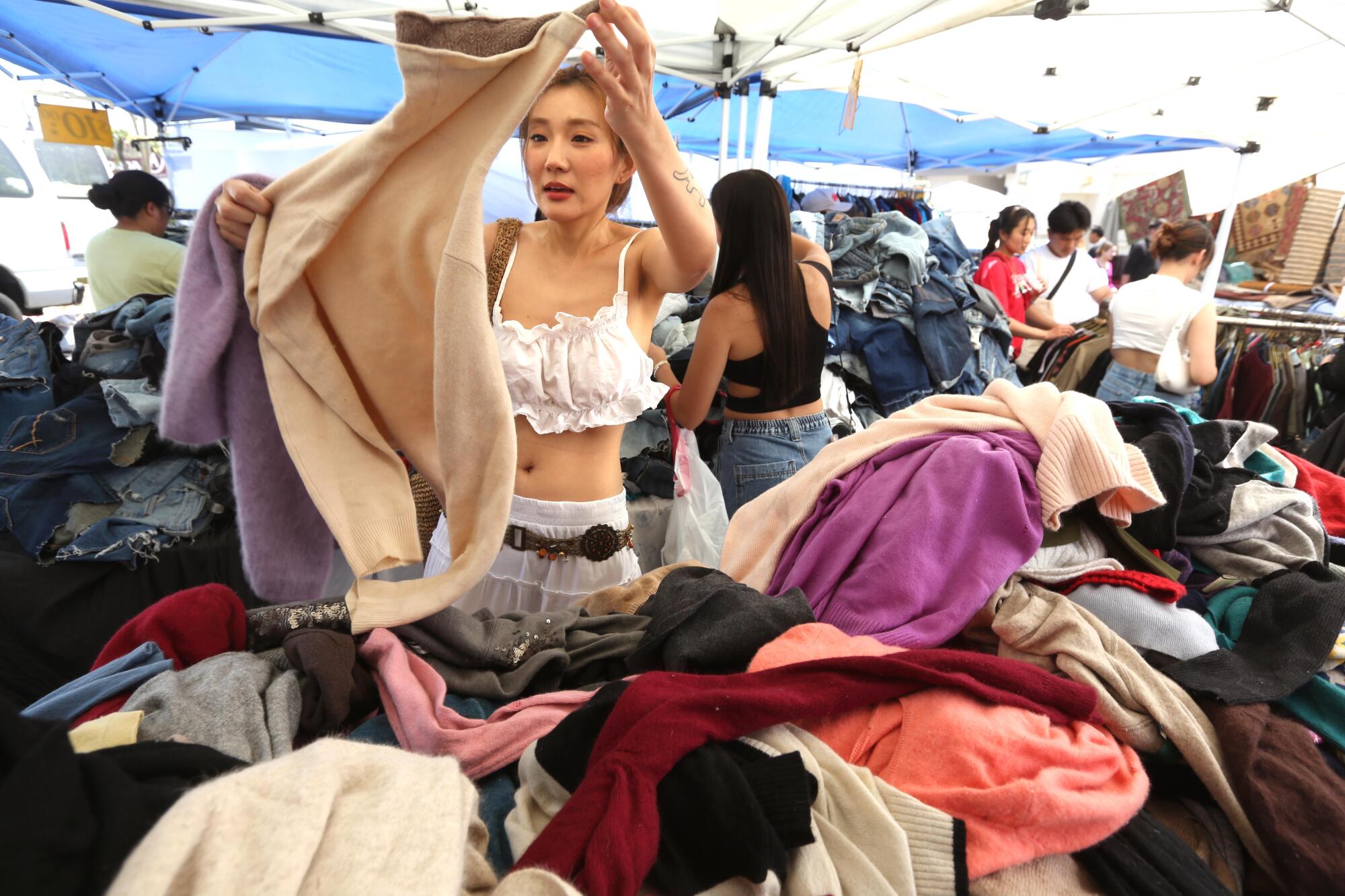Before Lindsey Rempalski buys a new dress, she often tries to sell an old one.
Most of the time, the process requires just a few minutes and taps on her phone: She snaps several photos of the clothing item, names her price and lists it on Depop, one of her digital resale platforms of choice.
Rempalski, 26, a content creator who lives in Los Angeles, proudly says that the items in her closet are “always in circulation,” both to maximize space in her apartment’s small closet and to rotate new garments into the mix without feeling like she’s contributing to the fashion waste cycle.
Plus, running a mini-business reselling your own clothing, she says, makes buying new items almost feel free. If you have the good stuff, that is.
Peer-to-peer digital resale platforms have been around for decades but have reached new levels of popularity since the pandemic, and their ubiquity is changing the way consumers shop and think about fashion.
Online resellers are no longer just super-enthusiasts or young shoppers who want some pocket money. Consumers, no matter their income bracket, are treating their clothing and accessories as assets, justifying their “investment purchases” with the relative ease of reselling today. And it’s not just in the categories of watches and streetwear — women’s accessories such as designer handbags and coveted vintage apparel are now seen as a new class of investments.
Mik Yu, who has a side hustle selling clothes, shops for bargains at the Rose Bowl Flea Market in Pasadena on Sunday. She goes thrifting every weekend.
(Genaro Molina / Los Angeles Times)
More people than ever are using resale sites to make money or score a deal. The RealReal, a site specializing in high-end designer goods, has seen a notable uptick in its user base in the last few years. In the first quarter of 2020, the site had more than 600,000 active buyers. Now, it has around 1 million.
Samantha McCandless, the chief merchandising officer at the RealReal, thinks that 2020 was an inflection point in the industry. McCandless said she was surprised when sales of secondhand designer handbags surged during the pandemic, despite economic uncertainty and few occasions to wear said pieces.
“I used to say to myself, ‘Where are people wearing the handbags?’ but it wasn’t because they were wearing them, it was because they wanted the investment value in them, and they started to realize that holding on to the goods was a really smart investment and a great way to spend money and time.”
Designer fashion and bags may seem like smart purchases in uncertain economic times because the value can, theoretically, always be recouped. “I think that that’s sort of, again, our secret sauce,” McCandless added of the RealReal’s success. “Because even during a recessionary environment, because that perceived value is there, I think that we will continue to trend.”
Regardless of the consigning platform, the process to list and sell items of value is incredibly simple. DIY sites like Poshmark and Etsy-owned Depop automatically generate shipping labels when an item is purchased: Sellers then pack up their items, stick the label on the package and drop it off at a post office. Platforms that hold and photograph the items themselves — like the RealReal — offer an option to pick up a seller’s items at home for free.

Lindsey Rempalski is passionate about sustainable fashion and likes to shop secondhand, either online or at local flea markets, to avoid creating clothing waste.
(Francine Orr / Los Angeles Times)
Most popular platforms make money by taking a cut of what each item sells for, usually between 10% and 20%. The RealReal takes more — between 25% and 80% — based on the item’s price range.
“The barrier of entry for designer resale is definitely lower than it’s been before,” said Chelsey Nordyke, the merchandising and curation manager at the peer-to-peer resale platform Poshmark. “Anyone can start to resell their items online and can post a listing in under 60 seconds.”
Poshmark has 8.2 million active buyers, a record number for the platform and a 13% increase year over year, according to the company’s most recent earnings report.
Rempalski said she thinks about an item’s resale potential “with almost every single piece of clothing I buy.”
“It’s just a good way to keep clothes always moving from other people’s closets into yours and also save money,” she said.
But, in order for this system to work, Rempalski’s items have to generate interest and sell relatively quickly. In other words, her closet has to be filled with in-demand clothes and accessories that hold most of their value over time.
There is a distinct disappointment of watching an item languish on the secondhand market, with the owner never able to recover its perceived value. Rempalski knows the feeling well, so she shops accordingly. She eschews fast fashion — which is often hard to resell and loses much of its value instantly — in favor of high-quality pieces, often from a designer brand. Or she shops for vintage clothing with a classic look.
It’s not a perfect system. Some investment buys, even made by the most stable brands, can lose value if they unexpectedly fall out of style or the market is oversaturated with similar goods.
Rempalski resold a Gucci bag that she bought new for close to $1,300 because the purse was no longer her style. It had big gold Gs on the front, which, to her, “felt really gaudy” after a couple of years. She wore it only for special occasions, so it was in good condition. To her surprise, it sold for $971 and she received just $614 after the resale site took its cut — less than half of what she initially paid.

Juyoung Yoon, an architect by day, shows off a collection of vintage purses. They’re all available for purchase on her Depop storefront as part of her second job, a side hustle reselling vintage clothing.
(Jay L. Clendenin / Los Angeles Times)
Clothes from brands like Reformation and Réalisation Par usually generate good returns, she says, along with vintage denim. Most of the handbags she owns now were bought secondhand, including a vintage Chanel single flap bag that she scored on the RealReal.
Analysts note that, right now, the wealthiest people are accounting for an even larger chunk of luxury spending than usual, citing high inflation and economic pressure for hampering the usual activity of so-called “aspirational shoppers.” But aspirational shoppers are still shopping — they’re just being deliberate about how.
“For the aspirational shopper, they are more concerned with products that have an intrinsic value,” said Sarah Willersdorf, the global head of luxury at Boston Consulting Group. “And partly that’s because of things like resale, but it’s also partly the justification to oneself around [buying] them.”
During the pandemic, Willersdorf said, stimulus checks led aspirational shoppers to participate more than usual in the luxury market. “Checks that maybe should have been spent on other things [were] being spent on luxury sneakers, luxury T-shirts, luxury small leather goods,” she said.
The economic landscape looks much different today. In the post-pandemic economy, consumers have more to spend their money on than online shopping. Americans are spending more on dining out than groceries, and costly travel is not deterring young customers from booking flights and hotels.
Americans are also carrying a record amount of credit card debt, close to $990 billion, according to the Fed’s latest data.
Willersdorf refers to this urge to keep spending, despite having less money on hand, as “lifestyle creep.” “Consumers, certainly once they dip their toe in, it’s hard to pull back,” she said.
Savvy shoppers have become more adept at managing their own mini resale businesses to help offset costs.
It helps that some of the luxury brands that tend to hold their value well — think Birkin maker Hermès, Louis Vuitton, Chanel and Gucci — have raised prices noticeably in recent years, pushing them further out of reach. Chanel has hiked its handbag prices four times since the beginning of the pandemic, according to a recent report from the auction house Sotheby’s. The Medium Classic Flap bag — one of the brand’s most iconic styles — now retails for $10,200, which is 16% more than in 2022, and 10 times more expensive than it was in the 1990s.

Juyoung Yoon wears a vintage Chanel houndstooth jacket from her personal collection at home in Los Angeles.
(Jay L. Clendenin / Los Angeles Times)
Juyoung Yoon, 35, an architect who lives in Sawtelle, has taken advantage of the Chanel boom to make a profit of her own. Yoon started selling her old clothes on EBay more than five years ago but decided to turn it into a serious side hustle last year.
“It started as just selling clothes that I’m not wearing anymore, but then I realized I can actually make profit out of it,” she said. “I found myself just, you know, being good at finding good deals.”
She specializes in rare vintage designer pieces, such as handbags and Chanel suits and jackets, and spends about an hour a day tending to her digital storefronts.
Yoon now has a Depop storefront in addition to her EBay one, where she estimates that 80% of the clothes and bags that are listed were purchased specifically to resell on the platform. She also sells on the website Vestiaire Collective, a resale site where “serious collectors” shop, she said. “I think Vestiaire people are actually looking to collect really expensive items so they’re less afraid to spend a lot of money.”
One vintage Chanel suit she listed for $750, a creamsicle orange linen set from the 1990s, sold on Depop in just one day. She also has three Chanel bags listed, ranging in price from $1,450 to $4,200.
Despite running a business that’s making more than $2,000 a month in profits, Yoon still carefully considers the resale value of her own wardrobe. “I try to shop less at fast fashion, because that’s the hardest thing to sell for me,” she said. “If I buy some pants from, like, Zara, I spend $50 but then that’s gone.”
Mik Yu has a similar story. For years, Yu, 33, sold old clothing for extra cash, but became more adept at playing the game as time went on. During the pandemic, Yu said she made between $6,000 and $10,000 a month from her side hustle reselling clothes and bags. Now things have leveled off, netting her between $3,000 and $4,000 monthly, supplementing her income from her job as a pattern maker.

Mik Yu has been reselling since 2010 and has fine-tuned her personal shopping strategy over the years.
(Genaro Molina / Los Angeles Times)
Yu has been reselling since 2010 and has fine-tuned her personal shopping strategy over the years. “I do spend a lot of money but I’m very rational,” she said. “Trendy” items are off the table for risk of their value dropping quickly. “So I always invest my money on the classic and timeless styles.”
Any stigma of buying secondhand versus new feels like a thing of the past. Consumers are increasingly open-minded to buying something used, and it can often be a badge of honor.
“I think that what previously people saw as, like, used or dirty is not that,” Nordyke, of Poshmark, said, adding that many consumers pride themselves on having a sustainable wardrobe, keeping fashion in circulation and out of landfills.
Willersdorf agrees: “Resale is driven by many things, but for the most part, consumers are looking for value.”
Credit: Source link
